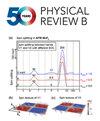Electric field driven domain wall dynamics in BaTiO3 nanoparticles
IF 3.7
2区 物理与天体物理
Q1 Physics and Astronomy
引用次数: 0
Abstract
We report a detailed investigation into the response of single BaTiO3 (BTO) nanocrystals under applied electric fields (E-field) using Bragg coherent diffraction imaging. Our study reveals pronounced domain wall migration and expansion of a sample measure under applied electric field. The changes are most prominent at the surface of the nanocrystal, where the lack of external strain allows greater domain wall mobility. The observed domain shifts are correlated to the strength and orientation of the applied E-field, following a side-by-side domain model from Suzana []. Notably, we identified a critical electric field strength of 3 MV/m, which leads to irreversible structural changes, suggesting plastic deformation. The findings highlight how surface effects and intrinsic defects contribute to the enhanced dielectric properties of BTO at the nanoscale, in contrast to bulk materials, where strain limits domain mobility. These findings deepen our understanding of nanoscale dielectric behavior and inform the design of advanced nanoelectronic devices.求助全文
约1分钟内获得全文
求助全文
来源期刊

Physical Review B
物理-物理:凝聚态物理
CiteScore
6.70
自引率
32.40%
发文量
0
审稿时长
3.0 months
期刊介绍:
Physical Review B (PRB) is the world’s largest dedicated physics journal, publishing approximately 100 new, high-quality papers each week. The most highly cited journal in condensed matter physics, PRB provides outstanding depth and breadth of coverage, combined with unrivaled context and background for ongoing research by scientists worldwide.
PRB covers the full range of condensed matter, materials physics, and related subfields, including:
-Structure and phase transitions
-Ferroelectrics and multiferroics
-Disordered systems and alloys
-Magnetism
-Superconductivity
-Electronic structure, photonics, and metamaterials
-Semiconductors and mesoscopic systems
-Surfaces, nanoscience, and two-dimensional materials
-Topological states of matter
 求助内容:
求助内容: 应助结果提醒方式:
应助结果提醒方式:


